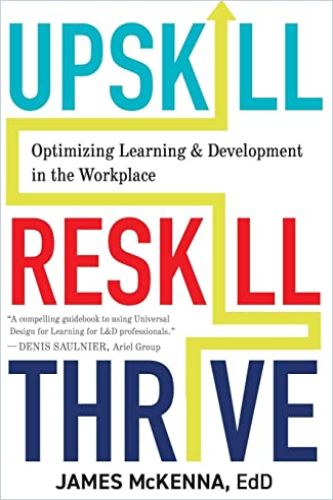Professional learning and teaching expert James McKenna provides a comprehensive program to help companies best enable their people to learn and retain new skills.

Experts Who Take Action
Assistant director of professional learning and leadership development at the California Collaborative for Educational Excellence, James McKenna, explains how Learning and Development (L&D) can apply Universal Design for Learning (UDL) to meet individual needs, empower learners, and remove emotional and physical barriers to learning.
Reorganize and Prioritize
When employees must learn new processes, companies often treat that learning as an add-on or extra task, McKenna writes. Typically, management hands down learning assignments, which higher-ups regard as separate from workers’ everyday activities. In the post-pandemic economy, change happens too quickly for this old model to remain effective.
Instead of focusing on building content, let’s focus on building capacity and culture. Let’s develop and support expert learners: individuals who know how to learn, how to share that learning, and work collaboratively to adapt and innovate.James McKenna
More companies are investing in upskilling – teaching people new skills for their current roles – and reskilling – teaching people skills that let them transfer to different roles. Upskilling and reskilling enable the people closest to a function or a problem to adapt, create solutions and teach others, regardless of their corporate title or position.
Many current learners work remotely, seek collaborative experiences, want to learn on-demand, and don’t have time to wait for their companies to provide upskilling or reskilling training. These employees rely on personal networks for advice, use online courses and pursue self-improvement.
Learners’ attitudes vary with their aptitudes, McKenna notes. Novice learners wait for others to give them something to learn; expert learners strategically seek information so that they can learn for themselves.
Understanding our learners allows us to make learning much more personalized.James McKenna
People learn at different paces, and how they learn changes as they mature, so no single strategy serves everyone. Help learners become experts who take action, strategically decide what to learn, and know how to obtain, absorb and use the knowledge they want.
The Universal Design for Learning (UDL) supports expert learners and aligns with how the brain learns. People have three neural networks that learning must engage to enable effective information retention. The UDL’s guidelines offer learning principles that address each of the brain’s networks.
“Affective networks” help people emotionally connect to the reason they need to learn. The UDL “Principle of Engagement” targets these networks to boost learners’ dedication to learning.“Recognition networks” tap into the brain’s physical process of receiving, organizing and remembering knowledge. The UDL “Principle of Representation” feeds this network by smoothing the path to absorbing new material and connecting it to what the learner already knows.“Strategic networks” sort out ways to use and share information. The UDL “Principle of Action and Expression” addresses these networks to help people apply what they learn to solve problems and meet their objectives.
The three networks interact like dancers in a ballet; if one is missing, the connections fail. A sound learning environment addresses all three networks, McKenna argues.
The learning environment ecosystem includes teaching methods, resources, culture, technology, support systems, personnel and the physical space for learning. A stale, cold environment that lacks support, collaboration or fun impedes learning.
Empathy and High Expectations
Empathy, expectations and a sense of ownership build the necessary mind-set for creating a thriving, support-driven learning environment. A deep, emotional understanding of people’s needs can transform individuals, teams and the organization at large – and unlock the creative capacity for innovation.
To build empathy, McKenna states, talk to learners, colleagues and professionals about how to reach people at all levels and from all backgrounds. Find out how they like to learn and what they want to learn.
Set high expectations. Help people learn and succeed. Take ownership of your mistakes and successes. This helps others to do the same, keeps everyone accountable and demonstrates your commitment to people’s continual learning.
Information Retention
The basics of learning call for the brain to gather outside information, process it and store it. Some people learn more quickly than others. Provide a variety of approaches that help people process and retain new information.
Reduce distractions in the learning space. If noises or interruptions are an issue, provide noise-canceling headphones, move to a quieter area or make people turn off their phones. Focused attention boosts people’s ability to take in and process information. Offer various content platforms to make knowledge as accessible as possible. If you’re showing a video, turn on closed captions. Give people options to view, hear or read the lesson.
Be clear on what you expect learners to grasp, McKenna writes. Provide tables, graphs or other visuals. Help learners “integrate” new and old information to find meaning. People can handle only so much data at one time, so provide manageable pacing and flexible timing.
Managers, learning facilitators and teachers must ensure that people have clear strategic avenues for applying their creativity and knowledge to their work and to the new tasks they learned to perform.
Goals, individuals and teams will be even more empowered when they decide what it will look like to meet the goal and how they are going to make that happen.James McKenna
Boost creativity through activities such as “hack-a-thons” or “design labs” that provide time and space for people to share knowledge. Communication tools such as Slack ease and speed collaboration and resource access. To learn and then apply their knowledge, people must know what resources are available, who to talk to and where to get help.
Review
James McKenna maintains that no matter how your employees learn, they can succeed if you give them the right kind of support. He describes this support in terms of learning environments, learning and retention techniques, interpersonal skills, a willingness to accept that everyone learns differently, and the need for every business to align its teaching methods to a fast-moving post-pandemic environment. Though many of his suggestions seem more common sense than groundbreaking, McKenna merges them into a practical, applicable solution almost any business can apply. His comprehensive approach ensures that companies embracing McKenna’s UDL technique will need no other system to reskill and upskill their workforce successfully.





